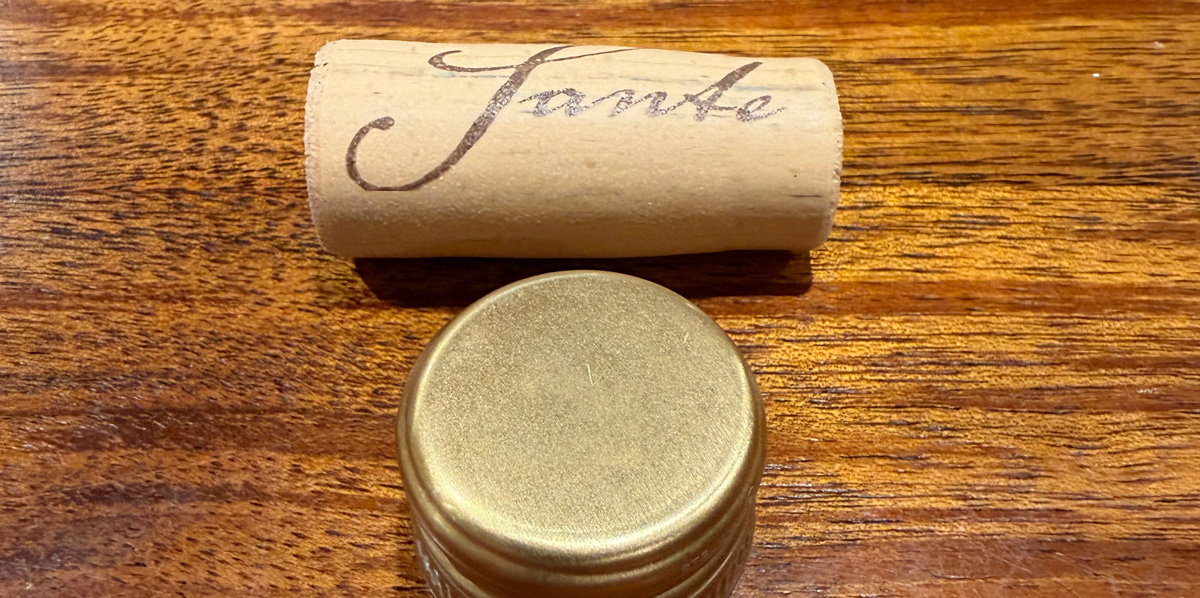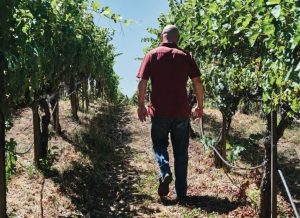As bottling of the 2024 Rosé of Pinot Noir and the 2023 Chrysanthemum and Syrah approaches, I thought this would be a good time to revisit the subject of wine closures. A year or so ago I posted here to explain my reasoning to try out screw caps on the 2022 Chardonnay, as a means of seeking a resolution to what had become an ongoing consistency issue with the very expensive natural cork closures I had been using for a decade. I explained the problem with natural cork as follows:
While 1-by-1 TCA testing has done a lot to resolve issues of cork taint in my wines (it’s down from 3-4% of bottles to around 1% or less), the natural cork, however high-end, has not resolved the issue of bottle variation during aging. Natural cork has many merits: it’s renewable, it’s beautiful-looking and… well… it’s natural. But that very thing means it is naturally unique, from one cork to the next. If one cork has a few more abberations in the grain than another, that will affect the OTR (oxygen through rate) of the cork. More oxygen ingress in a wine results in different aging. So one bottle that’s 5-10 years old can be radically different than another bottle of the exact same wine.
In the time that has passed, I’ve been able to collect a bit of sensory data on this decision. Recently I was selected to be a panelist at a prestigious White Burgundy seminar at World of Pinot Noir, alongside Louis Latour, Albert Bichot, Ramey and other iconic producers. Naturally, I was terrified to show my wines alongside such spectacular wines… so I had to decide which of my recent Chardonnays was the best to show. As it happened, each of the 3 had a different closure, but were made in largely the same way from the same vineyard (Split Rail).
The wines
- 2021 Split Rail Chardonnay;
- 2022 Split Rail Chardonnay;
- 2023 Split Rail Chardonnay.
- 2021 Split Rail Chardonnay in a One-by-One TCA-tested natural cork;
- 2022 Split Rail Chardonnay with a permeable screwcap;
- 2023 Split Rail Chardonnay with a Nomacorc Select Green.
One would expect to find a clear evolutionary path among these wines, with the 2021 being the most developed and the 2023 being the least. This was not the case at all.
The first bottle of 2021 I opened absolutely stole the show. It had developed better than expected, with all the freshness I wanted, but with really fine-tuned oak integration and a measure of elegance it had not shown when younger. With that knowledge in-hand, I quickly decided this would be the wine I would show at the seminar. However… when I opened another bottle, it had not aged quite as gracefully. There was a clear bottle variation among the two. The 2nd bottle was good– no doubt about that– but it showed a tad more “aged” quality than the first. Splitting hairs, to be sure, most people would not notice this difference. But it’s my job to split hairs. It wasn’t exactly the same as the first bottle. So, through no fault of my own, I am now worried about showing this wine at the seminar.
The 2022, with a Saranex liner in a screwcap, showed very little development at all. It was still largely the same as it was when I bottled it. Happily, I was happy with the wine when it was first bottled, and I’m still happy with the wine. But the oak had not integrated yet. It still showed like a very young wine, that would need more time. From my previous blog post:
Screwcaps these days are mildly permeable– Saranex has an OTR of 0.7mg O2/year. Screwcap OTRs are consistent from one to the next, which is a good thing because that permeability allows the wine to further develop in the bottle. Natural cork, however, according to a 2015 Wine Business Monthly report summarizing several industry studies, “can have extremely variable OTR, due to the intrinsic structural variability of cork itself (Godden et al. 2001). Measures (Lopes et al. 2005 and 2006) under conditions of humidity simulating those occurring in a wine bottle indicate values between 0.05-3.35 mg of oxygen per year even for a very limited sample size.”
However, my findings after tasting the 2023 after the 2022 lead me to believe that perhaps the advertised .7mg/year OTR on Saranex may not be totally accurate. The 2023 was sealed with a Nomacorc – an environmentally-friendly, TCA closure with a fixed OTR of 0.3 mg of O2 after 3 months, 0.4 mg of O2 after 6 months, 0.7 mg of O2 after 12 months and 0.6 mg of O2 per year, after the first year. The 2023 showed an ideal amount of development for a wine only 6 months in the bottle. Granted, the oak integration was still very much showing as a young wine — it needs more time– but it was more developed already than the 2022 wine was. The development of the wine was exactly as I expected it to be at this young age. And the next bottle was exactly the same.
I should mention that all 3 wines were bottled at exactly .8 molecular SO2, and with exactly the same amount of dissolved oxygen (I measure and adjust dissolved oxygen in the wines while they are in the bottling tank).
I like the ritual of pulling a cork out of a bottle vs twisting off a screwcap, and I love the look of natural cork. But with TCA still being an issue even in the pre-tested natural corks, and with the variable OTR of natural cork, I just don’t see myself going back. Cork was an ingenious solution to the need for closures… 1000 years ago. You strip the bark off a cork oak, you hole punch the cork out, and you stuff it in a bottle. Great idea. And, while I’m a big fan of tradition and honoring “the old ways”, I think scientific advances shouldn’t just be ignored due to dogma.
I’m very impressed with Nomacorcs so far. They’re made from a very renewable resource (sugarcane, in most cases), have a tiny carbon footprint, are compostable, last a long time in the bottle, have zero TCA and a very consistent OTR. This is the direction I will chart my course along for the time being, as they provide the ritual that screwcaps lack, they look good, and (so far) the results I’m getting are better than I expected from a non-“cork” cork.
What’s the point of all this? The next time you open a bottle that has what looks like a synthetic cork, don’t immediately assume the winemaker is cutting corners, or that the wine is “a cheap wine”. It may be a case like my case… where the winemaker has spent years and risked entire vintages trying to provide a product that is as consistent and age-worthy as it can be.



